
Image © 2020 Scott Rose
Is it possible to have a Kemetic Christmas tree?
That is, one with any merit in Kemetic neo-pagan culture. Would the concept of the Kemetic Christmas tree have any valid connections to ancient Egypt, its customs and religion? Or would it be a mere construct based on the wishful thinking and creativity of the practitioner? On the other hand, if we cannot avoid the blending and merging of cultures, aren’t we better off to simply embrace such a cultural diffusion, to work with it and see where it leads? Or would that be disastrous?
These represent a myriad of questions I’ve asked myself this holiday season, in response to my own inner stirrings. Of course, the short answer to the Kemetic Christmas tree is, no. The ancient Egyptians never set up fir trees in their dwellings each year nor proceeded to decorate them with mini Nefertiti busts, as I have. The Kemetic Christmas tree therefore, should not exist. To try and assemble one, in many ways seems a misguided venture, with only loose associations to Germanic paganism at best. At worst, it could be seen as blasphemy and an affront to the gods. This is not ancient Egyptian religion at all!
And yet, the stirrings persist.
Confronting the Western, mainstream holiday season as a first-year Kemetic has evoked a number of questions, consultations and experiments regarding what to do about Christmas. For me personally, it’s been a sorting of the sacred from what can be sacked. This is a process which, I imagine, would be different for each person who experiences it. When restructuring our world view and core beliefs, it can be a challenging and even volatile issue for some, with the potential to spark debate (though perhaps not for everyone, and I do acknowledge the ease of transition that many people demonstrate; it’s an amazing degree of resiliency).
In response to possible debate, I would re-affirm that a Kemetic Christmas tree is not a custom from ancient Egypt. Rather, it is an adaptation of current customs based on an eclectic approach to Kemeticism.
What remains up for debate is whether or not such adaptations enhance or detract from Kemetic practice. Again, the outcome I predict, would be predictably diverse for each person.
I’ll attempt to explain why I’ve put up a Kemetic Christmas tree this year, which was purely experimental. In the first instance, I wasn’t fully cognisant of all my reasons for putting up the tree. I suppose it was to see how it would feel — if it felt right. Something, or rather, someone was telling me not to abandon Christmas altogether, particularly the Christmas tree. To do so would be to throw the baby out with the bath water. I don’t know how I knew this, but I trusted my own intuition and the netjeru, who were not communicating a great deal with me on the issue (i.e. there were very few direct clairaudient messages) other than to encourage me to keep digging, keep looking, keep searching for… I wasn’t sure what yet.
I cannot help but wonder if the ancient Egyptians would have embraced the Kemetic Christmas Tree in the form of a decorated, sacred evergreen if the custom had been introduced to them.
While we can safely say that conifers did not grow in ancient Egypt and there does not appear to be any evidence of large-scale cultivation, we do know that through trade, the ancient Egyptians had access to pine products and used them extensively. Pine resin, along with other resins such as Myrrh, were used in the embalming process as far back as 4200 BC (see the 2014 article, Evidence for Prehistoric Origins of Egyptian Mummification in Late Neolithic Burials by Jana Jones, et al). Pine resin and pine nuts were both listed as key ingredients in recipes for making the complex and well-known temple incense, kyphi / kapet two examples of which, can be found in the Ebers papyrus and also written on the walls of the Temple of Philae (see the works of Lise Manniche, as cited by J Hill).
Given the relationship the ancient Egyptians had with pine and pine products, it seems unlikely that they would have been altogether opposed to further ceremonial and religious applications of the conifer, since pine was already so familiar to them. This alone is a good case for the Kemetic Christmas Tree.
We can only speculate how the ancient Egyptians would have reacted to sacrificial trees adorned with precious ornamentation, shining with lamps hanging from their branches. This may have been seen as an offering to the gods or perhaps the manifestation of a goddess or god themselves. Again, this is purely speculation on my part. Whether or not the Kemetic Christmas tree could be considered authentic in any way by Kemetic neo-pagans and included in contemporary ritual, is a matter of choice. I am proceeding with honouring the Tree of Life conceptualised as a Kemetic Christmas tree. This may have been influenced by a recent mystical experience I had with an Acacia goddess, along with other experiences I haven’t had time to document yet.
This is just scratching the surface of available information I wanted to share in this post. Due to holiday demands and the fact that it’s now Boxing Day in Australia (the day after Christmas) at the time of this post, I think it’s better to continue this later with at least one additional part, so please look for a link in the comment section below to part two in the near future, if the topic is of interest to you. Thank you for reading Kemetic Blog. Stay safe and well!
𓆸
© Scott Rose / Kemetic Blog – All Rights Reserved.

2 Comments
Scott Rose
January 2, 2021 at 12:09 pmArrgh! I have not had time to complete part 2 of this post yet. All my source materials and notes are in a nebulous sort of form and time is marching on, so what I’ll do is file them for now, and hopefully revisit this next secular holiday season. Essentially, while the ancient Egyptians did not have Christmas trees they did have an affinity for evergreens as well as apparent tree cults, where certain trees were sacred, the sycamore in particular. This obviously factored into the ancient experience of religion. Stay tuned for this and more — thanks for reading, Scott
A Case for the Kemetic Christmas Tree -- Part 2
December 13, 2021 at 7:38 am[…] they were no strangers to products such as pitch and pine nuts, a fact I discussed last year in part 1. While the ancient Egyptians didn’t have Christmas trees as we know them today, of course, […]